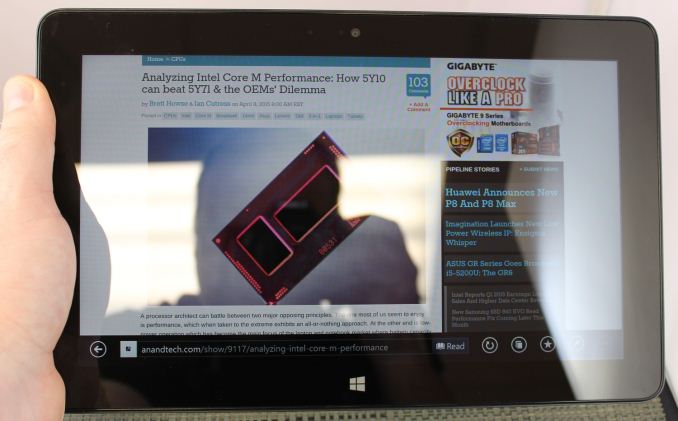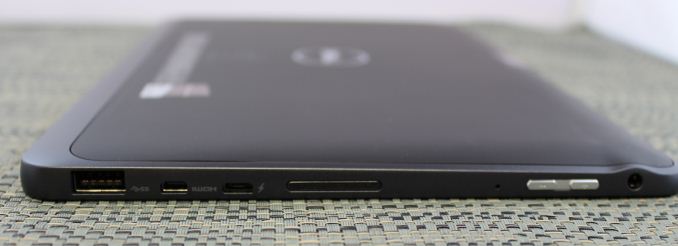The Dell Venue 11 Pro 7000 Review
by Brett Howse on April 16, 2015 8:00 AM EST- Posted in
- Tablets
- Dell
- Windows 8.1
- Core M
Design
Dell’s previous model of the Venue 11 Pro 7000 included a Core i5 processor, which meant it was thicker and heavier than this year’s model. The outgoing model also included the necessary fans to keep the Core i5 cool. The move to Broadwell-Y, or Core M as it is known, changes all of this. The device is now passively cooled, and acts much more like a tablet than before. The weight has also been slimmed down a bit, with the new model coming in at 723 grams. That is a bit under the 800 grams of the Surface Pro 3, although that device is also a bit bigger with its 12 inch 3:2 display.
The display in the Venue 11 is a 1920x1080 IPS model, and that defines the initial tablet experience. It includes generous bezels, which make it easy to hold the device without accidentally touching the display, and the bezels make using Windows 8’s edge gestures a snap. Dell moved to their “Infinity Display” which has minimal bezels on their Venue 8 Android tablet, and while it looks fantastic, it can cause usability issues with the tablet, so keeping the display bezels on this tablet is a good thing.
There seems to be some movement away from 16:9 displays, especially in the tablet space. Apple of course uses a much more square 4:3 ratio on their tablets, which make them a lot easier to use in portrait mode. 16:10 would be better for this tablet, or even squarer like the 3:2 of the Surface Pro 3 and just announced Surface 3 might improve ergonomics of this tablet. When using it in portrait mode, it is incredibly tall and a bit awkward. In landscape, it is a lot better, but still some more vertical height in that mode would be appreciated to help balance the weight when holding it in one hand.
The styling of the Venue 11 is a bit pedestrian, but is nonetheless functional. The glass front has an accurate touch digitizer, and includes the stylus support. The sides are nicely rounded and comfortable in the hand. The power button is on the top right corner, and the volume rocker is on the top left. One questionable port location is the full sized USB port, which is on the bottom left size. If you have something plugged into the USB port, you could not be able to hold onto the device with your left hand. The micro USB power connector is only slightly higher, and can certainly cause an issue if you are holding the device while it is being charged. It would be nicer to see both of these ports moved up on future models. The right side of the tablet has a covered slot for a micro SD card, as well as a chassis lock.
The back of the Dell is covered in a soft-touch coating, which makes it very easy to hang on to and you never feel like it is going to slip out of your hands like some other devices. The rear also houses the 8 Megapixel camera, which is angled a bit to make it a bit easier to use when the tablet is tilted.
Overall, Dell has crafted a sturdy and comfortable successor to their previous Venue 11 Pro, and with the move to Core M it is a much better tablet than before. There are a few issues which may bother some people, such as the display ratio and location of the charging and USB ports, but in the end it is a reasonably thin and light tablet with enough power to be a laptop replacement for many people.














92 Comments
View All Comments
MrSpadge - Thursday, April 16, 2015 - link
Well Said! I'm not going to buy Core M because I value performance over mobility - yet this doesn't make it a bad product. If you want maximum performance at high mobility, nothing comes close to Core M.dj_aris - Thursday, April 16, 2015 - link
Core M is in fact a new cpu category on it's own, a cpu that resembles the single core performance of "core" cpus while in the Atoms' TDP envelope (at least before it throttles!). But, as with every new product, it's overpriced at launch. Wait for the Skylake release, I say.lilmoe - Thursday, April 16, 2015 - link
That's the main point. It's REALLY overpriced.xthetenth - Thursday, April 16, 2015 - link
Pay a pretty high price for the absolute best burst performance for a snappy device. I've heard much worse than that.smilingcrow - Thursday, April 16, 2015 - link
The M-5Y71 is the same price as the i5-4300U in my laptop with the same base & turbo boost clocks for the CPU. Given the same cooling as my laptop has it should perform very similarly for CPU loads. Not fussed about GPU loads so haven't focussed on that but seemingly it will struggle to match the U series when both are stressed.Marc GP - Thursday, April 16, 2015 - link
A category where they can only keep this performance for short bursts before having to low their frequency from 2,8Ghz (turbo) to their nominal 1Ghz (where you don't get any much performance than on a simple Atom).ppi - Thursday, April 16, 2015 - link
Even in the benchmarks, where sustained performance is necessary, Core-M is some 25% slower compared to 15W Broadwell. ONLY.This effectively means, that if task is pain on Core-M, it will be pain on 15W Broadwell as well. I.e. if some task is not snappy and requires waiting on Core-M, it requires waiting on Broadwell as well. And only desktop class chips may have the oomph to be significantly faster.
I do not count in games, but nobody considers Broadwell-U gaming SoC either.
smilingcrow - Thursday, April 16, 2015 - link
If you had read the recent detailed Anandtech overview of Core M you would see that is a fallacy. I was surprised how well Core M does in a fanless laptop versus one with a Broadwell i5 that is fan cooled. And even more how well it does in a tablet where surface temperate is more of an issue so throttling is more prevalent.A Core M-5Y71 in my Latitude E7440 with a slightly beefier cooler would I imagine come close to my i5-4300U even for extended loads. This is purely for CPU loads as the GPU is another issue that doesn’t concern me.
MrSpadge - Thursday, April 16, 2015 - link
When it throttles it's actually entering Atoms TDP envelope. Before that it's allowed to use more power for short periods. That's the whole point of a Thermal Design Power.zepi - Thursday, April 16, 2015 - link
If you don't care about absolute performance, Intel is happy to sell you a Baytrail for quite a bit cheaper.If you do... Well, no one else can match Core M's CPU-performance even remotely.